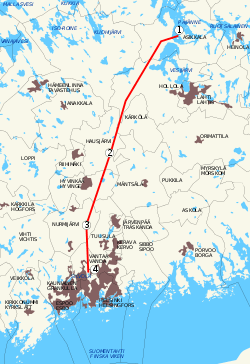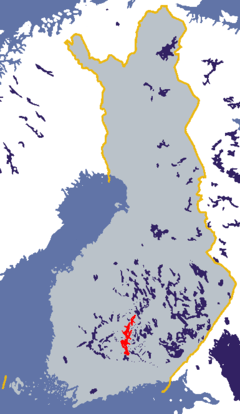Päijänne Water Tunnel
The Päijänne Water Tunnel (Finnish: Päijännetunneli, Swedish: Päijännetunneln), located in Southern Finland, is the world's second longest tunnel (after the Delaware Aqueduct in the USA). It is 120 kilometers (75 mi) long and runs 30–100 meters under the surface in bedrock.[1][2] The purpose of the tunnel is to provide fresh water for the million plus people in Southern Finland in the cities of Helsinki, Espoo, Vantaa, Hyvinkää, Järvenpää, Kerava, Kauniainen, Kirkkonummi, Sipoo, and Tuusula. The former Porvoo Rural Municipality, now merged with the municipality of Porvoo, also took part in the building of the scheme but has never drawn water from it for domestic use.

1. Asikkalanselkä
2. Kalliomäki water distribution station
3. Korpimäki water pump station
4. Artificial lake of Silvola
The tunnel starts at Asikkalanselkä in Lake Päijänne, which is the second largest lake in Finland, with an area of 1,080 square kilometres. The tunnel slopes slightly downhill so that water flows naturally. Water from the southern portion of Lake Päijänne is of rather good quality at the water tunnel intake and is usually drinkable without processing. The tunnel ends at the Silvola reservoir in Vantaa in the Greater Helsinki area. From the reservoir covering 0.5 square kilometres, water is pumped to water treatment plants in Pitkäkoski and Vanhakaupunki. Since the constant low temperature in the deep tunnel ensures high quality during transport, only minimal processing is required before use.
Tunnel construction started in 1972 and was completed in 1982 at a cost of approximately €200 million (adjusted for inflation).[3] In 1999 and 2001, portions of the tunnel required repair due to rock falls.[4][5] In 2008, the tunnel underwent an extensive renovation. The southern part of the tunnel was reinforced in order to prevent cave-ins. During the renovation, from April 15 to December 31, 2008, the raw water for the Greater Helsinki metropolitan area was drawn from the Vantaa River.
The tunnel has a cross section of 16 square metres (wide enough for a truck) and enables a water flow of 10 cubic metres per second. At current water usage rates, treatment plants take water at a rate of about 3.1 cubic metres per second for drinking water processing. The tunnel can be used as an emergency water reserve during water supply disruption.
Gallery
 Location of Lake Päijänne in Finland.
Location of Lake Päijänne in Finland. The artificial lake of Silvola, where the Päijänne Water Tunnel ends.
The artificial lake of Silvola, where the Päijänne Water Tunnel ends.
See also
- List of further tunnels by length
References
- "The water comes from Päijänne". Helsinki Region Environmental Services Authority HSY. Retrieved 24 February 2017.
- Hukka, J. J.; Juuti, P. S.; Katko, T. S.; Seppala, O. T. (1 October 2006). "Many Ps Needed for Sustainable Water Services: Expansion of the Scope of Public-Private Partnerships". Public Works Management & Policy. 11 (2): 104–109. doi:10.1177/1087724X06294063.
- "Yleistä Päijänne-tunnelista" (in Finnish). Helsingin vesi. Retrieved 2008-10-12.
- Mikkola, Jannis; Viitala, Raimo (April 2000). "Cave-ins in the Päijänne Tunnel and their repair". Tunnelling and Underground Space Technology. 15 (2): 129–138. doi:10.1016/S0886-7798(00)00040-7.
- Lipponen, Annukka (2006). Topographical, structural and geophysical characterization of fracture zones: implications for groundwater flow and vulnerability. Helsinki: Finnish Environment Institute. ISBN 952-11-2346-X.